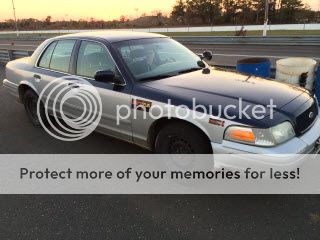Background, Reason for Attending, Course Selection
I’ve been interested in taking an “advanced” driver course for some time now. I have committed a fair amount of time and money to firearms training. I have committed some to medical training. I’ve spent some time learning empty-hand skills. None of that training really addresses the time when I am statistically most at risk: While driving my car. There were 21,626 total violent crimes in Indiana during 2011 vs 188,132 motor vehicle accidents in the same year. (I made no attempt to compare injuries, narrow it to accidents with injuries, remove less-violent crime like larceny and theft, etc. I’m using broad numbers just to make a comparison.) I have a fairly long commute at about 70 miles one way, and do a fair bit of travel for work. I spend a lot of time behind the wheel. All of the above leads me to believe my risk of injury or death is probably much higher from a car accident than a violent encounter with a bad guy.
I am not a professional driver, I do not do executive protection work, I’ve never been a police officer, and I was not in the military. As much as I would love to learn counter ambush techniques, PIT maneuvers, evasive driving, and how to spot a tail, if I’m honest with myself, I really have no practical need for those skills. Those kind of classes typically range into the thousands of dollars, and that stretches my training budget a bit. I really wanted to take my girlfriend and my brother to the driving class as well, but neither has the financial resources to do it on their own. So I decided to pay their tuition to the course and that also made the longer, and more expensive (probably more fun) programs a no-go.
I was looking for a course that would address my needs as an average Joe on the road. I had heard of VDI through some folks at Tactical Response, and also from AARs posted online. It was a little out of the way (NJ), but I could not seem to locate anything local that fit the bill. Other schools were about the same distance, at the same or higher cost, but did not have endorsements from people I’d trained with.
The Basics
School: Vehicle Dynamics Institute
Course: Accident Avoidance
Date: October 25, 2014
Duration: 9 Hours
Location: Old Bridge Township Raceway Park 230 Pension Road Englishtown, NJ 07726
Instructor: Dan Donza
Assistant Instructor: Owen
Students: 12 students. Three women and nine men. Three students were teenagers who had been driving less than one year. The following INGO members were in attendance: Jackson, jason, BLOOVMAN (He just happened to be in the same class. We didn’t know he was going to be in attendance.)
Cost: $425.00
Stated Objectives:
Related Threads
Summary
This course teaches basic car control techniques and runs through a few drills to reinforce those techniques. Overall, we felt the course was worthwhile and provided good information and valuable experience. It is rare to get an opportunity to test your driving skills in a safe way under the watchful eye of a knowledgeable instructor.
Details
We arrived at the training facility around 0730 for a 0800 advertised start time. The course was to be conducted in the large, flat parking lot of the raceway park facility. VDI was running three classes that day. The class running next to us was Immediate Action Driving Skills. I never heard what the third class was. The class started off a little slow and we didn’t get started until 0830.

The class began with introductions. None of the students had any significant driver training. Three were teenagers who recently started driving. Most of the folks were from the local area, New York, New Jersey, a few from Pennsylvania. Dan Donza was the lead instructor for our class. He served 14 years as an NYPD driving instructor. Our assistant instructor, Owen, had served in the US Navy in various roles and several deployments to the Middle East.
After introductions, Dan explained some of the class objectives and started in on the classroom lecture. He explained that VDI’s primary business was teaching high-risk personnel (executive protection, military, and law enforcement) how to deal with ambushes and difficult car situations. He went on to say that vehicle accidents have many of the same elements and issues, such as limited time and space to deal with the problem, and the same tools (from a car/driver perspective) with which to deal with those issues.
The lecture continued with some general topics on how to drive more smoothly, where to look, and the three primary inputs we have to the car (brake, throttle, steering). Dan told us about “g’s”, which is a measure of a specific car’s ability to maneuver and handle turns. He also discussed how the average driver uses, or is capable of using, about 30% of the average car’s ability. The objective of this course was to get closer to 70% of the car’s ability. The lecture talked about timing, speed in feet per second, reaction times, mechanical delay, and other factors that would affect handling of the vehicle. He also covered tires, tire inflation, and the impact of both on car handling and maneuvering.
Before moving out to the cars Dan went over the safety protocols and we all signed safety waivers. He then diagramed and explained the first exercise on the white board. This would be the basic class format. We’d have an explanation and discussion of the exercise in the classroom then go out to the cars to do it live. Once out in the lot he demonstrated proper seat position, hand placement on the wheel, foot position on pedals, etc and we were broken in to pairs and assigned to a vehicle. The girlfriend and I were put in vehicle 4, a used Crown Victoria police car. Jason and my brother elected to run the course in a ¾ ton Chevy Suburban. Each car was issued a radio with which to communicate with the instructor.


Exercise 1: Slalom Course (4 cones)
The first exercise we ran was a four-cone slalom course. The objectives were to help students understand timing, weight transfer, and relative speed. The cones were spaced at 60 foot intervals. We performed several iterations of this exercise at increasing speeds between 28mph and 34mph (SUVs ran slightly slower on each exercise). Each exercise was done at a very specific speed. One instructor would stand off to the side and observe and/or coach over the radio while the other operated a radar gun to check our speed. The goal was to maintain an even speed through the maneuvers, stay close to the cones, and not hit any cones. Maintaining an even speed required accelerating through the exercise where it felt like slowing down was the right way to go. It was interesting, but after one or two runs it seemed pretty easy even at the highest speed. The biggest takeaway was that I needed to use more steering input than I expected to complete the exercise correctly.
Exercise 2: Brake and Turn
After lunch (provided by VDI), we came back to the classroom to discuss the second exercise. This exercise involved driving toward an array of cones set up with a lane that curved off to the right and a solid barrier of different colored cones at the back of the curve. There was a signal light set up just before the exercise area. For the exercise we would drive at the cone lane getting up to the prescribed speed. When our vehicle was a given distance from the obstacle the instructor would turn on the signal light which indicated we needed to brake hard (as hard as we could) and curve to avoid the obstacle (staying inside the curved lane). The cars were outfitted with a g-force meter to measure the amount of g’s present during our stop. Higher g’s indicated that we’d reacted faster from throttle to brake, and stopped faster. The cone lane measured our ability to control the car through the hard braking and avoid obstacles. This exercise was done at speeds between 36 and 44mph.
Exercise 3: Evasive Lane Change
The third and final exercise was called an Evasive Lane Change. This consisted of a set of cones indicating an entrance gate, a large array of cones laid out about the size of a car directly in the path of travel, and an exit gate opposite the car-sized obstacle. Two signal lights were placed at the entrance gate which the instructor used to signal the direction you should swerve just before you entered the obstacle. So the driver would drive toward the entrance gate, just before s/he was past the signal light (nearly to the obstacle) the instructor would signal indicating to swerve to the left or the right, and the driver would need to react by swerving in that direction around the car-sized obstacle, and back in to the original lane and out an exit gate (opposite the entrance gate). This was done at speeds between 28 and 32mph. I've included a crude diagram of the exercise below. The red cones at the top and bottom are the entrance and exit gates for the exercise. The yellowish-green cones at the bottom represent the placement of the direction signals.

When everyone had completed the last exercise at each speed we went back to the classroom for a quick wrap-up. Each student received a certificate of completion and a Res-Q-Me tool to take home.
Thoughts and Conclusions
Overall, we all thought the course was worthwhile and provided solid information. The exercises reinforced the concepts and provided some skill advancement. It is rare to get an opportunity to drive this way, and receive input from experienced instructors on how to improve or maintain better control of the vehicle. The primary take-aways included required steering input, accelerating through maneuvers rather than braking to avoid a collision, hand position on the steering wheel, appropriate tire pressure, and seeing the differences between the SUVs and the sedans.
There were a few things we saw as down sides to the course. There was significant down time. With 12 students in 6 cars, each student was only in the driver’s seat half the time. Each exercise was run one at a time. So even when we were in the driver’s seat, we did more waiting and watching than driving. We estimate we only spent about 10% of the class actually driving. The rest was spent waiting, watching, or riding. Each driver performed each exercise an average of four times. So 12 exercises per student for the day. Each lasting about 30 seconds makes for about 6-10 minutes of actual driving time for the course.
If there had been additional instructors to allow us to run two groups in parallel, or fewer students to allow VDI to squeeze in an additional exercise or two, we’d have felt like we got more value for the time and money spent. We don’t want to come off like the course was poorly managed. In fact, we felt the instructors did a great job with the time and resources available. Exercises were set up while we were in the classroom being briefed. They moved students through in an organized manner saving time where they could. At no point did we feel held up by the instructors methods, but with the number of students and cars, the downtime could not be avoided.
The only other downside is that we didn’t feel like we hit the top end of our ability, or really learn our limits. Exercises were conducted at relatively low speeds and after a couple iterations didn’t seem too difficult. We went in hoping to have an opportunity to learn more about our limits. However, we understand this is not a racing class, and it is open enrollment. The intent is to teach the principles, and to do so safely. However, this is another area where we’d like to have seen a little more and learn a little more about ourselves as drivers.
Overall we feel the course was worthwhile and provided a valuable experience. If this class were local, I’d say it was worth every penny. As it was, it required 20-some hours of drive time for the round trip and a hotel stay for four people. When you add that in, the value proposition shifts the other way a bit. I will say the VDI instructors were professional and knowledgeable. The course was well-run and the exercises were informative. If I could find a local class like this, at a similar price point, I would probably attend periodically just to keep up the skills and get the experience.
I would also say, based on my experience in this class, I would recommend VDI’s longer format classes. If the travel time and costs were defrayed over a three day course with 3-4x as many exercises and drive time, it would have seemed much more worth the effort. I did talk briefly with a gentleman from the Immediate Action class, who had previously taken the Protective Driver course, and he highly recommended both.
I’ve been interested in taking an “advanced” driver course for some time now. I have committed a fair amount of time and money to firearms training. I have committed some to medical training. I’ve spent some time learning empty-hand skills. None of that training really addresses the time when I am statistically most at risk: While driving my car. There were 21,626 total violent crimes in Indiana during 2011 vs 188,132 motor vehicle accidents in the same year. (I made no attempt to compare injuries, narrow it to accidents with injuries, remove less-violent crime like larceny and theft, etc. I’m using broad numbers just to make a comparison.) I have a fairly long commute at about 70 miles one way, and do a fair bit of travel for work. I spend a lot of time behind the wheel. All of the above leads me to believe my risk of injury or death is probably much higher from a car accident than a violent encounter with a bad guy.
I am not a professional driver, I do not do executive protection work, I’ve never been a police officer, and I was not in the military. As much as I would love to learn counter ambush techniques, PIT maneuvers, evasive driving, and how to spot a tail, if I’m honest with myself, I really have no practical need for those skills. Those kind of classes typically range into the thousands of dollars, and that stretches my training budget a bit. I really wanted to take my girlfriend and my brother to the driving class as well, but neither has the financial resources to do it on their own. So I decided to pay their tuition to the course and that also made the longer, and more expensive (probably more fun) programs a no-go.
I was looking for a course that would address my needs as an average Joe on the road. I had heard of VDI through some folks at Tactical Response, and also from AARs posted online. It was a little out of the way (NJ), but I could not seem to locate anything local that fit the bill. Other schools were about the same distance, at the same or higher cost, but did not have endorsements from people I’d trained with.
The Basics
School: Vehicle Dynamics Institute
Course: Accident Avoidance
Date: October 25, 2014
Duration: 9 Hours
Location: Old Bridge Township Raceway Park 230 Pension Road Englishtown, NJ 07726
Instructor: Dan Donza
Assistant Instructor: Owen
Students: 12 students. Three women and nine men. Three students were teenagers who had been driving less than one year. The following INGO members were in attendance: Jackson, jason, BLOOVMAN (He just happened to be in the same class. We didn’t know he was going to be in attendance.)
Cost: $425.00
Stated Objectives:
- Learn crash avoidance techniques.
- Be smoother with a car.
- Learn to operate at 70-75% of vehicle capability (where most people use 30% of that capability).
Related Threads
Summary
This course teaches basic car control techniques and runs through a few drills to reinforce those techniques. Overall, we felt the course was worthwhile and provided good information and valuable experience. It is rare to get an opportunity to test your driving skills in a safe way under the watchful eye of a knowledgeable instructor.
Details
We arrived at the training facility around 0730 for a 0800 advertised start time. The course was to be conducted in the large, flat parking lot of the raceway park facility. VDI was running three classes that day. The class running next to us was Immediate Action Driving Skills. I never heard what the third class was. The class started off a little slow and we didn’t get started until 0830.

The class began with introductions. None of the students had any significant driver training. Three were teenagers who recently started driving. Most of the folks were from the local area, New York, New Jersey, a few from Pennsylvania. Dan Donza was the lead instructor for our class. He served 14 years as an NYPD driving instructor. Our assistant instructor, Owen, had served in the US Navy in various roles and several deployments to the Middle East.
After introductions, Dan explained some of the class objectives and started in on the classroom lecture. He explained that VDI’s primary business was teaching high-risk personnel (executive protection, military, and law enforcement) how to deal with ambushes and difficult car situations. He went on to say that vehicle accidents have many of the same elements and issues, such as limited time and space to deal with the problem, and the same tools (from a car/driver perspective) with which to deal with those issues.
The lecture continued with some general topics on how to drive more smoothly, where to look, and the three primary inputs we have to the car (brake, throttle, steering). Dan told us about “g’s”, which is a measure of a specific car’s ability to maneuver and handle turns. He also discussed how the average driver uses, or is capable of using, about 30% of the average car’s ability. The objective of this course was to get closer to 70% of the car’s ability. The lecture talked about timing, speed in feet per second, reaction times, mechanical delay, and other factors that would affect handling of the vehicle. He also covered tires, tire inflation, and the impact of both on car handling and maneuvering.
Before moving out to the cars Dan went over the safety protocols and we all signed safety waivers. He then diagramed and explained the first exercise on the white board. This would be the basic class format. We’d have an explanation and discussion of the exercise in the classroom then go out to the cars to do it live. Once out in the lot he demonstrated proper seat position, hand placement on the wheel, foot position on pedals, etc and we were broken in to pairs and assigned to a vehicle. The girlfriend and I were put in vehicle 4, a used Crown Victoria police car. Jason and my brother elected to run the course in a ¾ ton Chevy Suburban. Each car was issued a radio with which to communicate with the instructor.


Exercise 1: Slalom Course (4 cones)
The first exercise we ran was a four-cone slalom course. The objectives were to help students understand timing, weight transfer, and relative speed. The cones were spaced at 60 foot intervals. We performed several iterations of this exercise at increasing speeds between 28mph and 34mph (SUVs ran slightly slower on each exercise). Each exercise was done at a very specific speed. One instructor would stand off to the side and observe and/or coach over the radio while the other operated a radar gun to check our speed. The goal was to maintain an even speed through the maneuvers, stay close to the cones, and not hit any cones. Maintaining an even speed required accelerating through the exercise where it felt like slowing down was the right way to go. It was interesting, but after one or two runs it seemed pretty easy even at the highest speed. The biggest takeaway was that I needed to use more steering input than I expected to complete the exercise correctly.
Exercise 2: Brake and Turn
After lunch (provided by VDI), we came back to the classroom to discuss the second exercise. This exercise involved driving toward an array of cones set up with a lane that curved off to the right and a solid barrier of different colored cones at the back of the curve. There was a signal light set up just before the exercise area. For the exercise we would drive at the cone lane getting up to the prescribed speed. When our vehicle was a given distance from the obstacle the instructor would turn on the signal light which indicated we needed to brake hard (as hard as we could) and curve to avoid the obstacle (staying inside the curved lane). The cars were outfitted with a g-force meter to measure the amount of g’s present during our stop. Higher g’s indicated that we’d reacted faster from throttle to brake, and stopped faster. The cone lane measured our ability to control the car through the hard braking and avoid obstacles. This exercise was done at speeds between 36 and 44mph.
Exercise 3: Evasive Lane Change
The third and final exercise was called an Evasive Lane Change. This consisted of a set of cones indicating an entrance gate, a large array of cones laid out about the size of a car directly in the path of travel, and an exit gate opposite the car-sized obstacle. Two signal lights were placed at the entrance gate which the instructor used to signal the direction you should swerve just before you entered the obstacle. So the driver would drive toward the entrance gate, just before s/he was past the signal light (nearly to the obstacle) the instructor would signal indicating to swerve to the left or the right, and the driver would need to react by swerving in that direction around the car-sized obstacle, and back in to the original lane and out an exit gate (opposite the entrance gate). This was done at speeds between 28 and 32mph. I've included a crude diagram of the exercise below. The red cones at the top and bottom are the entrance and exit gates for the exercise. The yellowish-green cones at the bottom represent the placement of the direction signals.

When everyone had completed the last exercise at each speed we went back to the classroom for a quick wrap-up. Each student received a certificate of completion and a Res-Q-Me tool to take home.
Thoughts and Conclusions
Overall, we all thought the course was worthwhile and provided solid information. The exercises reinforced the concepts and provided some skill advancement. It is rare to get an opportunity to drive this way, and receive input from experienced instructors on how to improve or maintain better control of the vehicle. The primary take-aways included required steering input, accelerating through maneuvers rather than braking to avoid a collision, hand position on the steering wheel, appropriate tire pressure, and seeing the differences between the SUVs and the sedans.
There were a few things we saw as down sides to the course. There was significant down time. With 12 students in 6 cars, each student was only in the driver’s seat half the time. Each exercise was run one at a time. So even when we were in the driver’s seat, we did more waiting and watching than driving. We estimate we only spent about 10% of the class actually driving. The rest was spent waiting, watching, or riding. Each driver performed each exercise an average of four times. So 12 exercises per student for the day. Each lasting about 30 seconds makes for about 6-10 minutes of actual driving time for the course.
If there had been additional instructors to allow us to run two groups in parallel, or fewer students to allow VDI to squeeze in an additional exercise or two, we’d have felt like we got more value for the time and money spent. We don’t want to come off like the course was poorly managed. In fact, we felt the instructors did a great job with the time and resources available. Exercises were set up while we were in the classroom being briefed. They moved students through in an organized manner saving time where they could. At no point did we feel held up by the instructors methods, but with the number of students and cars, the downtime could not be avoided.
The only other downside is that we didn’t feel like we hit the top end of our ability, or really learn our limits. Exercises were conducted at relatively low speeds and after a couple iterations didn’t seem too difficult. We went in hoping to have an opportunity to learn more about our limits. However, we understand this is not a racing class, and it is open enrollment. The intent is to teach the principles, and to do so safely. However, this is another area where we’d like to have seen a little more and learn a little more about ourselves as drivers.
Overall we feel the course was worthwhile and provided a valuable experience. If this class were local, I’d say it was worth every penny. As it was, it required 20-some hours of drive time for the round trip and a hotel stay for four people. When you add that in, the value proposition shifts the other way a bit. I will say the VDI instructors were professional and knowledgeable. The course was well-run and the exercises were informative. If I could find a local class like this, at a similar price point, I would probably attend periodically just to keep up the skills and get the experience.
I would also say, based on my experience in this class, I would recommend VDI’s longer format classes. If the travel time and costs were defrayed over a three day course with 3-4x as many exercises and drive time, it would have seemed much more worth the effort. I did talk briefly with a gentleman from the Immediate Action class, who had previously taken the Protective Driver course, and he highly recommended both.
Last edited:



 ay less than 1k miles. I'd be surprised if they get over 500 miles per tire. Even though we put less than 10 miles on them, there was noticeable degradation on the outside edge at the end of class.
ay less than 1k miles. I'd be surprised if they get over 500 miles per tire. Even though we put less than 10 miles on them, there was noticeable degradation on the outside edge at the end of class.
